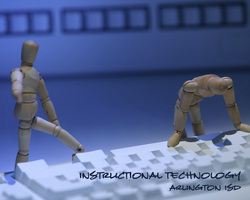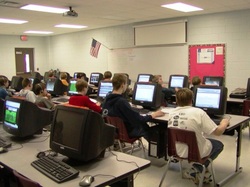Now, check technology applications.

Technology applications generally considered as softwares, but you also need other technology applications for school mission. For instance, you need to have electronic mail, communication technologies, internet, web access including web pages, access to onlinepages, and security related applications.
Avaibility of equipmet is very important for technology integration. Next step is technology applications. You should determine which applications important for school functions' are being run on the equipment.
You have lots of reasons for following installed softwares and applications. You should be sure that software is properly licenced. Unlicenced software is not running on school systems. Database of installed and permitted software and applications are the natural requirement for schools.
If you can answer the following questions, you can support applications to integrate the technology.
1. Do the school or district's instructional applications support teaching and learning standards across the curriculum?
2. Is there software support for technology tool skill development?
3. Does the school/district use technology applications to improve communication?
4. Does the school/district have appropriate software and systems to support primary administrative functions?
5. Are the applications in use evaluated for effectiveness?
Avaibility of equipmet is very important for technology integration. Next step is technology applications. You should determine which applications important for school functions' are being run on the equipment.
You have lots of reasons for following installed softwares and applications. You should be sure that software is properly licenced. Unlicenced software is not running on school systems. Database of installed and permitted software and applications are the natural requirement for schools.
If you can answer the following questions, you can support applications to integrate the technology.
1. Do the school or district's instructional applications support teaching and learning standards across the curriculum?
2. Is there software support for technology tool skill development?
3. Does the school/district use technology applications to improve communication?
4. Does the school/district have appropriate software and systems to support primary administrative functions?
5. Are the applications in use evaluated for effectiveness?
Defining technology applications

Technology applications consists of software and systems. They run on school equipment that provide significant administrative and and instrcutional functions. Technology applications consists of major components for school and districts.
- Administrative management software and systems: Financial accounting; staff attendance and payroll; budgeting; operations and planning, including transportation and food systems; facilities management; inventory control; and decision support;
- Instructional support software and systems: Instructional planning and management, including grading, testing, and individualized educational program (IEP) management; instructional support, including student attendance; access to remote educational resources; and distance education. Also included are assistive and adaptive systems, discussed in Chapter 7, Technology Integration;
- Communications support: Electronic mail; local- and wide-area networks; access to the Internet and remote educational and administrative sites; satellite uplinks and downlinks; and Internet-based telephony ("voice over IP," or voIP);
- Operating systems
- Security systems: firewall technology, and antivirus software.
